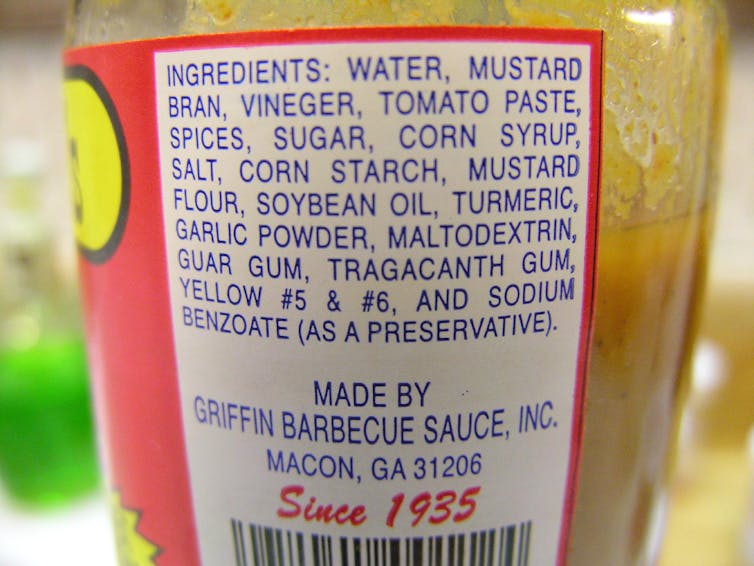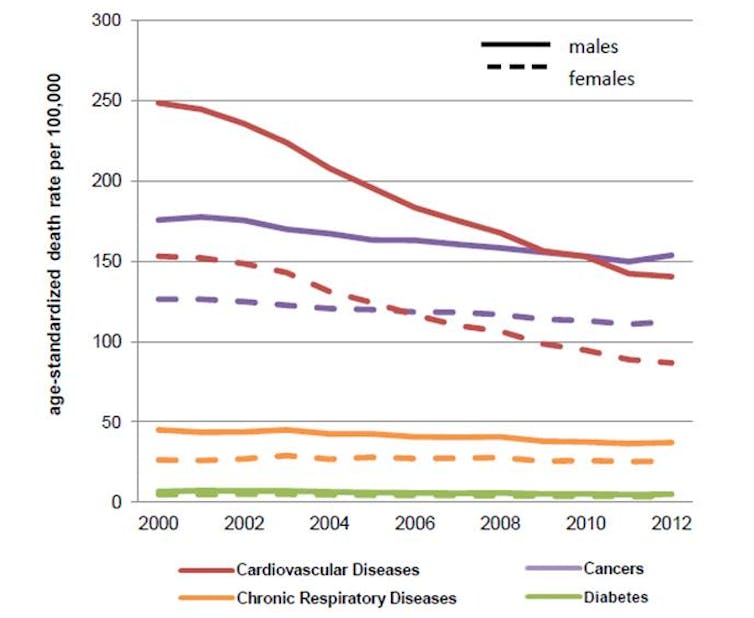Why food firms should be told what – and what not – to put in their products

When it comes to illnesses linked to poor health choices, there is good news and bad news. The good news is that the rates at which people die from them have been falling for some time. The bad news is that these diseases are still by far the most common cause of death. Cancers, heart disease, diabetes and the rest are still responsible for 89% of total deaths in the UK and other countries.
Neither is it just about mortality rates. It is also a question of wellbeing. With most of these ailments the result of tobacco use, physical inactivity, unhealthy diet, and too much alcohol, the effects will undermine the quality of life of sufferers well before they kill them.
There is also the economic impact. A report published last month suggested that obesity costs Britain £47bn a year, generating an annual loss equivalent to 3% of GDP.
UK mortality rates from lifestyle illnesses

On the food side of the equation, governments combat these problems by pursuing policies to change consumers’ habits and lead them to healthier dietary choices. This includes advertising campaigns like the UK’s 5 a Day, which has for years been used to encourage people to eat more fruit and vegetables. It can be through food labelling, such as nutritional information or traffic-lights systems to warn people about foods that are bad for them; or by imposing taxes on ingredients like fats (“fat tax” in Denmark – since abolished) or sugars (refined sugar products tax in Norway) or on whole ranges such as soft drinks (“soda tax” in Mexico).
The trouble with public health campaigns
None of this has been very successful, of course. Proposed healthy diets might often be cheaper and even more environmentally friendly, but it is an uphill struggle getting consumers to follow them. Obesity rates are still a major problem. I recently attended a presentation by a speaker from the Food Standards Agency that said that we were making very little progress in reaching our goals to improve nutrition in Scotland.One complication is that there are several factors that affect food decisions beyond price. Governments are up against our eating habits and arguable addictions to fat, sugar and salt; the little time we invest when choosing what to buy, and therefore reading labels; and the fact that we like to change consumption patterns to avoid boredom – eating habits often get worse at weekends, for example.
Yet in the face of these difficulties in shifting consumer behavior, governments have until recently been far less willing to focus on the manufacturers instead. Manufacturers can make their products healthier in broadly two ways – launching new products into the market or reformulating existing ones.
Opportunities knock
Obviously, food manufacturers have been in the business of developing new products to improve nutrition for many years. Companies will spot opportunities of the sort that Coca Cola clearly thinks it has found by presenting milk in the form of Fairlife.Sometimes the benefits can be debatable or misleading, such as low-fat yogurts with lots of extra sugar added. But even if we ignore these kinds of problems and take the health improvements at face value, new “healthy” products will only improve nutrition if they replace “unhealthy” products.

And unfortunately, these kinds of products comprise a much smaller share of the market than you might think. As the chart below shows, even in the soft drinks category, where diet soft drinks are a multi-billion-pound industry, they still comprise less than 50% of total sales.
And in the categories of savories and confectionery, they amount to under 5%. This strongly indicates that there is a low limit to the size of the market that you can reach by introducing healthier product alternatives in most categories.
What actually works
As for reformulating products, a recent analysis from the Institute for Fiscal Studies (IFS) indicated that people’s salt consumption was falling because manufacturers were removing salt from their products and not because consumers were choosing products with lower amounts of it (other groups have echoed these findings).Indeed, the IFS found that some consumers responded to lower-salt products by switching to equivalents with higher levels of it. This highlights a limitation with product reformulation – the fats, sugar, and salt are in the product to maximize their appeal in the first place, so some consumers will just switch brands. Unappealing products will also be discontinued if nobody buys them. Then there is the question of what is scientifically feasible – you can remove added sugar from fruit juice, but removing the sugar from a dessert is another matter.
All the same, this study does point towards a strategy that governments ought to take far more seriously. Since firms will be reluctant to risk losing their customers by reducing the bad stuff, forcing change across the board will often be the only way to make it happen. Governments are taking steps in this direction.
For instance the UK government set voluntary salt targets per serving for a number of categories of consumer foods earlier this year for the first time, echoing efforts elsewhere including Australia.

The UK government has also used voluntary agreements to reduce saturated fats in products. But this was criticized for missing big-name manufacturers and not being ambitious enough.
But what has been missing so far is mandatory action. It is not about scrapping public health campaigns since they keep consumers aware of the issues and signal to the industry what sort of products to offer.
Instead, it is a recognition that after many years of shiny campaigns that do not seem to work well, and unilateral pledges that have a habit of coming up short, this new approach is the best way forward. If you can’t change consumers’ choices, the only sensible option is to make those choices healthier.
Cesar Revoredo-Giha, Senior Economist and Team Leader of Food Marketing Research, Scotland's Rural College
This article is republished from The Conversation under a Creative Commons license.
.
<><><><><>
.
No comments:
Post a Comment
Note: Only a member of this blog may post a comment.